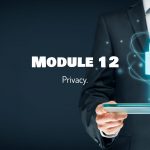Strategic Cybersecurity, Module 11: The Concept of Dataveillance.
This lecture discusses the concept of combining big data analysis with technical surveillance, or “dataveillance.” The module looks at two trends enabling the ability for dataveillance: nearly exponential increases in computer power and similar decreases in the cost of data storage.
The Objective
Once you have completed the readings, lecture, activity, and assessment, you will be able to
- Articulate Rosenzweig's concept of “dataveillance”
- Articulate problems with “dataveillance” with respect to authoritarian governments.
Welcome to Strategic Cybersecurity, Module 11. This module covers the concept of combining big data analysis with technical surveillance, or “dataveillance.”
The Cost of Dataveillance
Traditional surveillance methods have typically been physical in nature, with authorities tracking suspected criminals in the physical realm. For instance, consider the 2007 terrorist threat in Germany involving a three-person team of operatives of the Islamic Jihad Union, or IJU.
These IJU operatives cased numerous American bases in the country, looking for the most vulnerable to attack. Alerted fairly early, American authorities were able to track the terrorists as they sought high-concentration hydrogen peroxide to construct a bomb.
The authorities physically tracked the terrorists' movements for months, with reports that surveillance of each required four German counterterrorism agents per eight-hour shift. As you can imagine, the manpower required to track these terrorists each day for months cost the German government an exorbitant amount.
In fact, this was one of the largest surveillance operations in postwar German history.
We are slowly moving into a world where, increasingly, such physical surveillance is being replaced with electronic surveillance. This “dataveillance,” as Rosenzweig calls it, combines the surveillance techniques like facial recognition and gate analysis with analysis of a person's digital dust, which we leave whenever and wherever we go on the Internet and which, for all intents and purposes, is permanent.
Computer Power and Data Storage
As the readings for this module indicate, two trends enable the ability for dataveillance:
- (1) nearly exponential increases in computer power, and
- (2) similar decreases in the cost of data storage.
Increases in computer power are making it possible to quickly sort through and analyze fast reams of data, such as those produced by the faces and gates of hundreds of thousands of daily travelers passing through an international airport. And storing this data is becoming less and less expensive.
Think about this: In 1984, storage for 1 megabyte of data cost roughly $200. Today, we can purchase a tiny thumb drive with one terabyte of storage capacity for under $10. And these trends will only continue.
As Rosenzweig points out, these trends increasingly give both the government and corporations access to our lives and to our digital dust for some future purpose.
Big Data Analysis
Although we still have adequate protections inside our homes, problems arise as we enter the public sphere, where our every move can potentially be recorded and stored. We are rapidly losing the ability to live in practical obscurity.
The capabilities of big data analysis are not all bad, however. For instance, online retailers might sift through your purchase history and recommend products based on your preferences.
Police agencies will increasingly be able to operate more efficiently by digitally tracking terrorist suspects. Even so, we have a long way to go with perfecting these technologies.
NORA System
Think back to your reading in this module about the “Non-Obvious Relationship Analysis,” or NORA, system, that Las Vegas casinos employ to identify potentially threatening individuals. NORA may be a good system, but it was not good enough to identify Stephen Paddock, the Las Vegas shooter who killed nearly 60 people and wounded hundreds from his hotel-casino room's window.
In fact, given his lack of online presence and low profile over the previous decades, no system likely could have identified him.
To end the module on a good note, however, I will point out that the Islamic Jihad Union terrorists mentioned earlier where, with the purported help of NSA's big data capability, eventually arrested, prosecuted, and sent to prison.
Quiz
Quiz Question 1: Which of the following best describes the concept of dataveillance?
A: The use of Global Positioning System (GPS) to track potential criminals.
B: The collection and analysis of personal data and information about an individual or corporation.
C: A term coined by the Supreme Court indicating unlawful surveillance by police using unapproved technology.
D: The ability to sift through large data sets to determine someone's location.
The answer is B. The collection and analysis of personal data and information about an individual or corporation.
Quiz Question 2: True or false: The two trends that have facilitated the explosion and dataveillance are increases in computer power and decreases in the costs of data storage.
The answer is true.
Quiz Question 3: Which of the following is not a way that authoritarian governments are likely to use dataveillance capabilities?
A: To track suspected dissidents using facial recognition technology.
B: To help critics of the government travel anonymously while abroad.
C: To reduce the ability of its citizens to anonymously surf the Internet.
D: To identify foreign intelligence officers operating in their country.
The answer is B: To help critics of the government travel anonymously while abroad.
Activity
The activity for this module asks that you assess the amount of digital dust you have left in the past 48 hours. Include things such as the websites you have visited. Include the comments you have made onto social media. Do you allow Google to track your location through your cell phone? Think about the last time you checked your privacy settings on any social media you may have. What might an entity engaged in dataveillance on your internet habits learn about your life based on the digital dust you have left behind?
Go to: Module 12: Privacy
“Strategic Cybersecurity” by Augusta University is licensed under CC BY 4.0 / Original video transcribed and re-structured.


